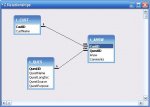I'm a medical resident trying to begin a small research study at my clinic. All I know about access is from a class I took in med school. @GrahamMandeno on this forum has helped me a lot with the coding part of the attached database but I'm stuck at a point. Thought I'd throw it out here in the community and see if someone has a more creative solution.
The basic idea was to convert a couple of paper based questionnaire's into electronic format. There were are more than 255 fields that need to be answered. So I created 2 separate tables and joined them through the ID field. Now I created several forms from the table. Did not want to add too much questions per form because it gets too lengthy and participants can loose interest.
The participants would click through each form (one at a time) and then at the end the last form will close. This all looked very good in theory but when put to practice, what ends up happening is that some of the data is entered into one row on the table and some is entered into another row (take a look at both the tables in the DB). I have tried many things but still unable to figure things out. Can someone take a look into the data and let me know their suggestions? I would really appreciate any help.
The basic idea was to convert a couple of paper based questionnaire's into electronic format. There were are more than 255 fields that need to be answered. So I created 2 separate tables and joined them through the ID field. Now I created several forms from the table. Did not want to add too much questions per form because it gets too lengthy and participants can loose interest.
The participants would click through each form (one at a time) and then at the end the last form will close. This all looked very good in theory but when put to practice, what ends up happening is that some of the data is entered into one row on the table and some is entered into another row (take a look at both the tables in the DB). I have tried many things but still unable to figure things out. Can someone take a look into the data and let me know their suggestions? I would really appreciate any help.

